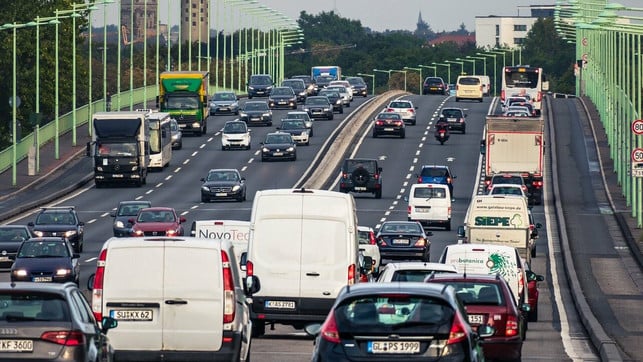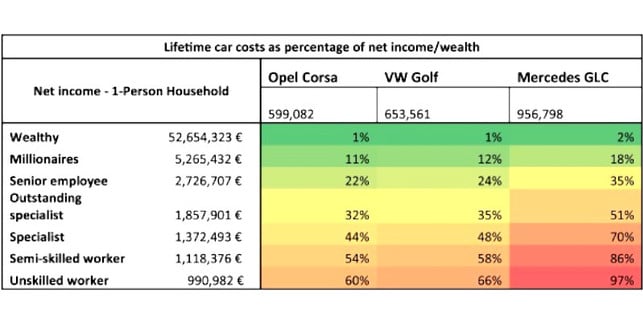Driving is really expensive – not just for drivers, but for society as a whole. This is the conclusion of a new study that calculates the true cost of cars and concludes: We all subsidize cars and their negative impacts on the environment and our health – with an average of €5,000 per year per car.
Cars cost money, a lot of money. Most people are aware of this. After all, in addition to the purchase price, we pay for fuel, parking, insurance, and vehicle tax. But these costs don't stop there; roads, parking lots, and noise barriers also have to be built and maintained.
So what are the true costs of a car? A new study, " The lifetime cost of driving a car ," published in January in the journal Ecological Economics, delves into the hidden costs of cars.
Study: Cars are much more expensive than most people think
Cars are one of the most expensive consumer goods. In the European Union, only housing and food are more expensive. Yet, according to the study authors, there is still little knowledge about the actual cost of cars for individuals and society .
Car owners significantly underestimate the total costs of their cars. Depreciation and repair costs, for example, are significant cost drivers that are often underestimated. Politicians, in turn, underestimate the social costs of cars.
The hypothesis of a 2020 study: If drivers knew the true costs of cars, significantly fewer people would buy one. The new study by Stefan Gössling, Jessica Kees, and Todd Litman therefore aims to examine the previously little-researched "external" or societal costs of automobiles in more detail.

In total, the study compares 23 private and ten social cost items for the three popular car models: the Opel Corsa, the VW Golf, and the Mercedes GLC for 2020. The comparison pits a small car, a mid-size car, and an SUV against each other.
The study authors include private expenses such as operating expenses, vehicle depreciation, and time spent in traffic jams . Social costs include, among other things, the construction of infrastructure such as roads and public parking spaces, the management of environmental and health impacts ( air pollution and noise), and traffic accidents . According to the study, these hidden costs influence our mobility behavior and traffic volume in Germany.
True car costs difficult to afford for middle incomes
One finding of the study: If car owners were to cover all costs themselves, only the super-rich would be able to afford a large and fast car. To test this hypothesis, the three researchers calculated the total costs of a car driver's life over 50 years, including all private and social costs, and passed on to the car owners. With a typical driving distance of 15,000 kilometers per year, this would cost
- an Opel Corsa 599,082 euros ,
- a VW Golf 653,561 euros and
- a Mercedes GLC 956,798 euros .
These figures represent the "true" costs of car ownership over 50 years. In reality, however , car owners don't bear these costs alone ; they are largely shared by the general population (read more about this below).
The study authors compare the true cost of owning a car with the income of German households (see graphic). If drivers had to cover all costs themselves, the study concludes: For the super-rich, buying a car hardly poses a financial challenge, as the car costs only one percent of their net income. For millionaires and managers, small and mid-size cars cost a maximum of 24 percent of their net income.

But even well-paid skilled workers have to shell out a good half of their income to buy an SUV like the Mercedes GLC. Skilled workers and skilled blue-collar workers pay around half of their net income for a small car. For skilled and unskilled workers, an SUV would consume almost their entire income (86 and 97 percent, respectively), and even a mid-size car like the VW Golf costs them around two-thirds of their income.
The graph makes it clear: While very rich people can easily afford several cars, lower-earning workers have to pay a large part of their total income
for a car .
The true cost of cars: Society finances every car with
The inequality becomes particularly clear when you subtract the social costs of cars from the total costs. Study author Stefan Gössling says: "When you ask drivers whether they pay for all the costs they cause, they nod their heads. They don't realize how heavily cars are subsidized."
However, according to the study, society pays €250,381 in social costs for a car like the VW Golf over a period of 50 years . This sum is explicitly not covered by taxes or duties.
Calculated annually, an Opel Corsa incurs social costs of €4,674 , while a Mercedes GLC incurs even more, €5,273. The social costs vary depending on the vehicle's size, weight, and driving characteristics. The higher social costs of SUVs result, in part, from increased air pollution due to increased greenhouse gas emissions .
One can therefore conclude: society pays a higher price year after year for particularly environmentally harmful cars like SUVs than for small cars. At the same time, only high earners can even afford such cars. With this policy, we are continually widening the gap between social classes – and at the same time, we are encouraging the purchase of environmentally harmful vehicles.
Conclusion: Promote environmentally friendly means of transport instead of cars
Conversely, it's not car drivers who should be subsidized, but people who cycle , walk, or use public transport. To date, these people also bear a large share of the costs of car owners. This is despite the fact that cyclists, pedestrians, and public transport users do not, or at least significantly less, pollute the public with particulate matter, nitrogen oxides, and noise. Traffic accidents without car involvement are also fewer and less dangerous.
Instead, public transport tickets are getting more expensive – Deutsche Bahn just raised its fares by an average of two percent, and many transport associations have also raised their prices. It's time for a true transport revolution : Politicians have a duty to act and end environmentally harmful subsidies like the company car privilege. At the same time, local and long-distance public transport must become more affordable and reliable.
But you too can make a difference in your everyday life by leaving the car at home when shopping , commuting by bike or train, and planning more time when visiting friends and walking more often. Of course, this doesn't always work and doesn't work for every distance, but if we're honest, we don't need our car for many journeys, using it primarily for convenience or because we think it's cheaper.
Read more on Utopia.de:

